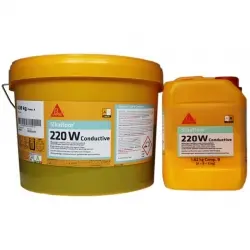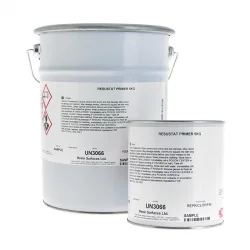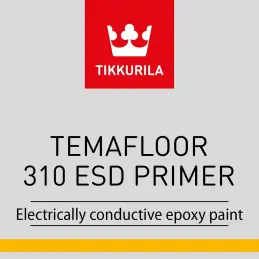- There are no more items in your cart
- Shipping Calculated at checkout
- Sub-Total (inc. VAT) £0.00
Need Help?
Anti-Static Primers
Anti-static primers from Rawlins Paints are highly electrostatically conductive with very low electrical resistance, ideal for industrial use in environments with high levels of electrical current such as manufacturing plants that work with electronic devices and medical equipment, vehicle fabrication, and some clean room environments. Our specialist anti-static primers are economical and easy to apply for use under conductive wearing courses on concrete and cementitious screeds, and static-dissipative resin flooring systems.

Sikafloor 220 W Conductive
2 part, water dispersed, epoxy resin primer with high electrostatic conductivity. Must be applied as a primer underneath all Sikafloor conductive wearing courses on concrete and cementitious screeds for different types of industrial use.Highly electrostatically conductive Easy application Economical in use Solvent free

RSL Resuprime ESD
Designed to be applied prior to the use of Resuflor SL ESD, Resustat SL23, FasTop TG ESD or Resuflor Terrazzo. It is a low viscosity epoxy primer with conductive fillers. Conductive with very low electrical resistance Good adhesion Low odour High solids Easy to apply Formerly known as Resustat CP and Resustat Primer

Tikkurila Temafloor 310 ESD
A solvent-borne, two-component, electrically conductive epoxy primer used for priming of Temafloor 4000 ESD grinding screed.Approx. 70% volume solids. At 23℃:Dust dry after 8 hours Recoatable after 24–48 hours Fully cured in 7 days
Need Help?
Need Help?
What Are Anti-Static Primers?
Anti-static primers are specialised coatings formulated to mitigate the risks of static electricity in environments where the build-up and discharge of static charges can cause significant harm. Static electricity, often generated through friction or movement, accumulates on surfaces such as floors, walls, and machinery. If not properly controlled, these charges can lead to unexpected discharges, damaging sensitive electronic equipment, igniting flammable materials, or causing malfunctions. Anti-static primers function by providing a conductive or dissipative layer that helps neutralise and safely disperse these charges, preventing sudden static discharge.
Critical Applications: Where Are Anti-Static Primers Used?
Anti-static primers are commonly used in industries where static electricity must be strictly controlled due to its potential hazards. Electronics manufacturing facilities often apply these primers to prevent static from interfering with delicate circuit boards and components. In pharmaceutical production, they are used to maintain safe working conditions by reducing static-related risks in sterile environments where explosive or flammable substances might be present. Chemical processing plants also rely on anti-static primers to prevent the accidental ignition of volatile materials. Other sectors that benefit from these primers include telecommunications, cleanrooms, and environments handling powders or gases, where static discharge could have devastating consequences.
Why Use Anti-Static Primers?
In environments where static electricity poses a threat, controlling it is not optional—it is vital for both safety and operational efficiency. Anti-static primers prevent the build-up of harmful charges on surfaces where staff or equipment are in constant contact. For instance, floors in electronics workshops may see frequent foot traffic, which generates static electricity that can easily damage sensitive equipment. Applying an anti-static primer reduces this risk by enabling the charges to dissipate gradually, eliminating the danger of sudden discharges that could interrupt operations or lead to costly repairs.
Target Surfaces: What Can Anti-Static Primers Be Applied To?
Anti-static primers are highly versatile and can be applied to a variety of surfaces. Commonly treated materials include concrete, which is often found in factory floors, metal surfaces such as machinery and equipment housings, and certain plastics that are prone to static charge. The versatility of these primers makes them suitable for a wide range of environments. However, it is essential to choose the right product for specific surface types and ensure proper preparation for the most effective application. Technical support can offer guidance on selecting the right primer for each surface.
FAQs
What types of industries benefit the most from anti-static primers?
Industries that handle sensitive electronics, explosive materials, or volatile chemicals benefit significantly from anti-static primers. Electronics manufacturing, chemical processing, pharmaceutical production, and cleanroom facilities commonly use these primers.
How often should anti-static primers be reapplied?
The longevity of anti-static primers depends on factors such as surface wear, exposure to chemicals, and the amount of traffic in the area. Most primers offer long-lasting protection, but high-traffic or industrial areas may require more frequent reapplication.
Can anti-static primers be used on vertical surfaces like walls?
Yes, anti-static primers can be applied to vertical surfaces such as walls, particularly in environments where static control is necessary for the entire room. Ensuring full coverage of floors, walls, and machinery can significantly reduce the risk of static discharge.
Is special equipment required to apply anti-static primers?
Applying anti-static primers typically does not require specialised equipment, but the surface preparation and correct application process are crucial for optimal results. Some environments may require professional installation to ensure that all surfaces are properly treated. Technical support can advise on the best approach for specific applications.
What preparation is required before applying anti-static primers?
Proper surface preparation is essential for the effective use of anti-static primers. Surfaces should be clean, dry, and free from any contaminants such as oils, dust, or grease. Depending on the surface material, additional priming may be required to enhance adhesion and performance.
